Bearded Grunter
Ken Neill
published in The Fisherman
Pogonias cromis is the scientific name of the Black Drum. It loosely means bearded grunter which is an apt name for these behemoths of the drum family. The black drum is the largest of the drum found in the mid-Atlantic. Other members of the drum family include red drum, croaker, spot, sea mullet, gray trout and speckled trout.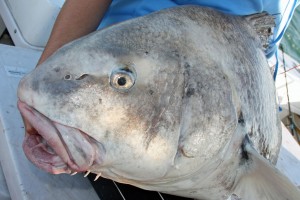
The booming grunt of the black drum is made through muscle contractions on the fish’s air bladder. These sounds are both loud and distinct and can easily be heard when there is a school of drum under your boat. The “bearded” part of the drum’s name refers to whiskers or barbels found on the chin. These barbels are used to help the drum feel food items on the bottom.
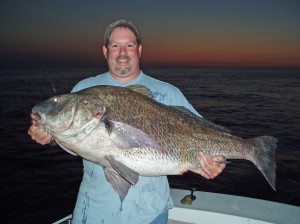 In addition to the chin barbels, the black drum’s dentition (teeth) are another specialized feature of this species’ feeding behavior. When you look in a drum’s mouth, you will not see a very impressive array of teeth. You have to travel further back, into the throat, to find the real choppers. Black drum are equipped with pharyngeal, molar like, teeth. These powerful teeth are there to crush clam, oyster, mussel, and crab shells. These are the preferred food sources of the black drum.
In addition to the chin barbels, the black drum’s dentition (teeth) are another specialized feature of this species’ feeding behavior. When you look in a drum’s mouth, you will not see a very impressive array of teeth. You have to travel further back, into the throat, to find the real choppers. Black drum are equipped with pharyngeal, molar like, teeth. These powerful teeth are there to crush clam, oyster, mussel, and crab shells. These are the preferred food sources of the black drum.
Black drum grow very large and live a long time. The largest specimens may be over 5 feet long and weigh as much as 150 pounds. These fish may live as long as 60 years. The sport fishing record black drum for Virginia weighed 111 pounds. The world record is a 113-pound fish caught in Delaware.
Black drum are ready to spawn when they are about 24 inches long and spawn they do. They will form large 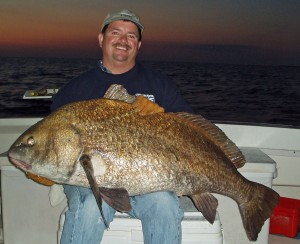 spawning aggregations from late April through early June. A single female drum may spawn twenty or more times during this period. While expending a lot of reproductive energy, these fish are also doing a lot of something else: eating. It is possible to encounter black drum in the mid-Atlantic all year long but it is during the spawn when fishing can be fantastic.
spawning aggregations from late April through early June. A single female drum may spawn twenty or more times during this period. While expending a lot of reproductive energy, these fish are also doing a lot of something else: eating. It is possible to encounter black drum in the mid-Atlantic all year long but it is during the spawn when fishing can be fantastic.
Where
These spawning aggregations occur in the Chesapeake and Delaware Bays and in some of the seaside inlets in between the two bays. Look for these aggregations of drum in depths in the 18 to 25 feet range. The fish tend to gather in the same general areas each year. In the Chesapeake Bay, they will gather in the Eastern Shore side of the 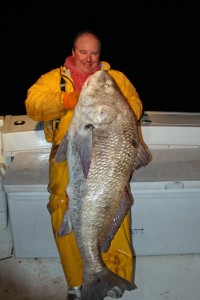 bay. The prime area runs between Latimer Shoal and the Inner Middle Ground from buoy 16 to buoy 13 on the bay side of the high rise section of the Chesapeake Bay Bridge Tunnel. Productive water will also be found on the oceanside of the high rise section in the area between buoys 10 and 8 and Fisherman’s Island.
bay. The prime area runs between Latimer Shoal and the Inner Middle Ground from buoy 16 to buoy 13 on the bay side of the high rise section of the Chesapeake Bay Bridge Tunnel. Productive water will also be found on the oceanside of the high rise section in the area between buoys 10 and 8 and Fisherman’s Island.
Slowly motor around these areas and look for the drum on your depth finder. During this time of year, there will be fleets of boats anchored over the productive areas. In general, when the bite is on at a certain location, the whole fleet is having success. If you see boats fighting fish, just anchor up and get fishing.
When
Black drum will feed both day and night. For some reason, they seem to feed most actively during the last few hours of daylight into the first few hours of the night. This the same time most spawning activity is supposed to occur. We have caught these fish at all moon phases and during both slack and hard running currents. I will say that it is much easier fighting these wide-bodied, powerful fish when the current is light. When the current is running fast, make sure that you are using enough weight to have your bait on the bottom. That is where the fish will be feeding. Many anglers feel that the bite is better around the full moon and will prefer a particular tide. I’ll fish for them anytime I can.
How
Once you have anchored up in a productive area, it is time to start fishing. Tackle in the 30-pound class is about right for these fish. Lighter tackle can be used with success but from an anchored boat when the current is running, lighter tackle can greatly increase fight times. Terminal tackle is a fish-finder rig with sinker on a slide above a swivel. Below the swivel is a leader of about 80-pound test monofilament about 3 feet long. This leads to an 8/0 size hook. Both circle hooks and J-hooks can be effective. Most anglers will use J-hooks due to the often subtle bites of these big fish.
Favorite baits are peeler and soft shell crabs and clams. The classic Chesapeake Sandwich drum bait is soft shell 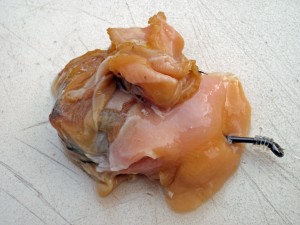 crab and clam on the same hook. Clam is the king of the black drum baits. Both chowder and and sea clams make excellent baits. The sea clam is larger and tougher. The chowder clam is more readily available and they keep better. Any leftover clams can be frozen (whole, in the shell) and saved for the your next trip. Use fresh clams for your hook baits. These frozen clams can be used as chum. Just crack the clam shells and dump the clams overboard to help draw and keep the school of drum around your boat.
crab and clam on the same hook. Clam is the king of the black drum baits. Both chowder and and sea clams make excellent baits. The sea clam is larger and tougher. The chowder clam is more readily available and they keep better. Any leftover clams can be frozen (whole, in the shell) and saved for the your next trip. Use fresh clams for your hook baits. These frozen clams can be used as chum. Just crack the clam shells and dump the clams overboard to help draw and keep the school of drum around your boat.
Put out several rods with your baits on the bottom. Watch the rod tips. Sometimes, these fish will eat very aggressively. Other times, they will just sit there and suck your bait off of the hook and may need to be holding the rod to feel the bite. With J-hooks, let them eat for a few seconds and set the hook. With a circle hook, just reel and see if you come tight. Circle hooks will work better when the fish eats your bait and swims away with it. When they just sit there, you may miss some fish with the circle hooks.
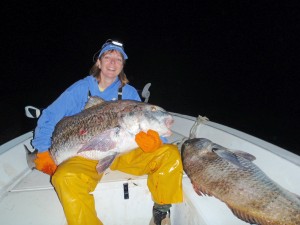 Once you are hooked up, expect a strong and dogged fight but they are not known for being speedsters. Once you finally get the fish boat side, you are going to have to land that thing somehow. Make sure that you have a very large landing net on board. Most of these fish will be released. If you going to keep one of these fish to eat, you have two choices: on ice in a large cooler or back over the side tied to the boat on a stringer. The stringer option is often chosen not because of a lack of cooler space but to use this fish as a decoy. That fish drumming behind your boat can help keep other drum near.
Once you are hooked up, expect a strong and dogged fight but they are not known for being speedsters. Once you finally get the fish boat side, you are going to have to land that thing somehow. Make sure that you have a very large landing net on board. Most of these fish will be released. If you going to keep one of these fish to eat, you have two choices: on ice in a large cooler or back over the side tied to the boat on a stringer. The stringer option is often chosen not because of a lack of cooler space but to use this fish as a decoy. That fish drumming behind your boat can help keep other drum near.
When you release one of these fish, they often will have a difficult time getting back to the bottom and will float away belly up. Likely, most of these fish will get their act together and get back to the bottom after a little rest. You can help them by holding them in the water, facing into the current, until they are ready to swim on their own. A lip gaff can help you hold onto these fish while they are recovering. We do not know what is happening to these fish after release. Tag return rates on large black drum are very low. This is also true of their cousin, the red drum. A recent study of large red drum, tagged with pop-up satellite tags, was conducted by Dr. John Graves at the Virginia Institute of Marine Science. All of the fish in this study survived the catch and release experience. A similar study 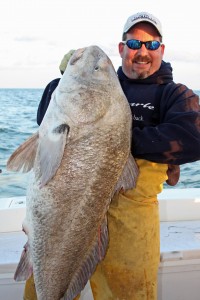 needs to be conducted with large black drum to confirm that these fish are as hardy as their red drum cousins.
needs to be conducted with large black drum to confirm that these fish are as hardy as their red drum cousins.
